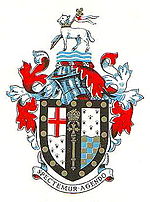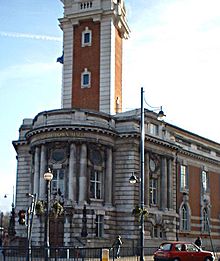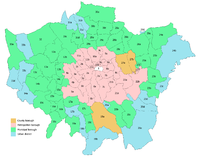- Metropolitan Borough of Lambeth
-
Lambeth Motto: Spectemur Agendo
(Let us be regarded according to our conduct)
Lambeth within the County of LondonGeography Status Metropolitan borough HQ Brixton Hill History Origin Lambeth parish Created 1900 Abolished 1965 Succeeded by London Borough of Lambeth Politics Governance Lambeth Borough Council 
Coat of arms of the borough councilThe Metropolitan Borough of Lambeth was a Metropolitan borough under London County Council from 1900 to 1965.
Contents
History
The borough covered the area of the former Lambeth parish vestry. In addition to the historic riverside area of Lambeth, this included Kennington, Vauxhall, Stockwell, Brixton, the western part of Herne Hill, Tulse Hill and Norwood. In 1965 the borough was amalgamated with the Streatham and Clapham parts of the Metropolitan Borough of Wandsworth to form the new London Borough of Lambeth.
Politics
The borough council was controlled by the Municipal Reform Party (allied to the Conservatives) until 1937, when the Labour Party gained power. Labour retained control until abolition in 1965.
For elections to parliament, the borough was divided into four constituencies, established in 1885:
In 1950 the borough's representation was reduced to three seats:
Town hall
Lambeth Town Hall was built in Brixton in 1906 – 1908. It replaced the former vestry Hall at Kennington Green.[1] The building is constructed of red brick and Portland stone, with a 41 metre high clock tower. Since 1965 it has formed the headquarters of the successor London Borough.
Population and area
The area of the borough in 1901 was 4,080 acres (16.5 km2). By 1961 it had increased slightly to 4,089 acres (16.5 km2). The borough was more than 7 miles (11.3 km) north to south, but only 2.75 miles (4.4 km) at its widest east to west. The population of the metropolitan borough as recorded at each census was as follows:
Civil Parish 1801–1899
Year[2] 1801 1811 1821 1831 1841 1851 1861 1871 1881 1891 Population 27,985 41,644 57,638 87,856 115,888 139,325 162,044 208,342 253,699 275,203 Metropolitan Borough 1900–1961
Year[3] 1901 1911 1921 1931 1941 1951 1961 Population 301,895 298,058 302,863 296,147 [4] 230,240 223,763 Coat of arms
When the borough was created in 1900, the corporation adopted a seal which was used in place of a coat of arms. The device was derived from that of the borough's forerunner, Lambeth Vestry. At the base of the seal was a lamb, a play on the name "Lambeth", and a symbol long used to represent the parish. The two shields were those of the Diocese of Canterbury and the Duchy of Cornwall. The first referred to Lambeth Palace, residence of the Archbishop of Canterbury. The second was to show that the Duchy owned estates in the Kennington area of the borough. The design was completed by the cypher of Queen Victoria, and the year of the borough's founding. This device can still be seen in the circular hall of Lambeth Town Hall.
In 1922 the borough obtained an official grant of arms from the College of Arms. The lamb was moved to the crest, on top of the helm. It was transformed into a paschal lamb supporting a pennon of St George. As a number of other crests featured a paschal lamb, a silver and blue wave, for the River Thames, was added. The arms themselves retained references to the Duchy of Cornwall (the black border charged with bezants or gold discs) and the Archbishop of Canterbury (the mitre and crozier). The red cross in the first quarter was taken from the arms of the London County Council, showing that the borough was in the county. The fourth quarter contained a gold and blue chequered pattern, the arms of the de Warennes, Earls of Surrey. This was included to show that Lambeth lay in the county of Surrey until 1889. The ermine patterning in the other quarter was said to stand for "purity and honour".[5]
The motto adopted was Spectemur Agendo, a motto common to several local authorities in England. Although this is generally rendered in English as Judge us by our deeds, the official translation in Lambeth has traditionally been the more ponderous Let us be regarded according to our conduct.
On 22 February 1966 the arms were transferred by royal licence to the London Borough of Lambeth. On registration at the College of Arms, two gold stars were added in the second and third quarters to depict the addition of Clapham and Streatham to Lambeth.
References
- ^ Lambeth Town Hall History
- ^ Statistical Abstract for London, 1901 (Vol. IV); Census tables for Metropolitan Borough of Battersea
- ^ Census Tables for the Metropolitan Borough of Lambeth, from the Vision of Britain
- ^ The census was suspended for World War II
- ^ Richard Crosley, London's Coats of Arms, 1928
Local government districts abolished or transferred by the London Government Act 1963 London · CC Battersea · Bermondsey · Bethnal Green · Camberwell · Chelsea · Deptford · Finsbury · Fulham · Greenwich · Hackney · Hammersmith · Hampstead · Holborn · Islington · Kensington · Lambeth · Lewisham · Paddington · Poplar · Shoreditch · Southwark · St. Marylebone · St. Pancras · Stepney · Stoke Newington · Wandsworth · Westminster · Woolwich
Constituent parts of Greater LondonEssex Barking · Chigwell (part) · Chingford · Dagenham · East Ham · Hornchurch · Ilford · Leyton · Romford · Walthamstow · Wanstead and Woodford · West Ham
Hertfordshire Middlesex · CC Acton · Brentford and Chiswick · Ealing · Edmonton · Enfield · Feltham · Finchley · Friern Barnet · Harrow · Hayes and Harlington · Hendon · Heston and Isleworth · Hornsey · Ruislip-Northwood · Southall · Southgate · Tottenham · Twickenham · Uxbridge · Wembley · Willesden · Wood Green · Yiewsley and West Drayton
Kent Surrey Transfers Categories:- Metropolitan boroughs of the County of London
- History of Lambeth
- 1900 establishments in the United Kingdom
- 1965 disestablishments
Wikimedia Foundation. 2010.



